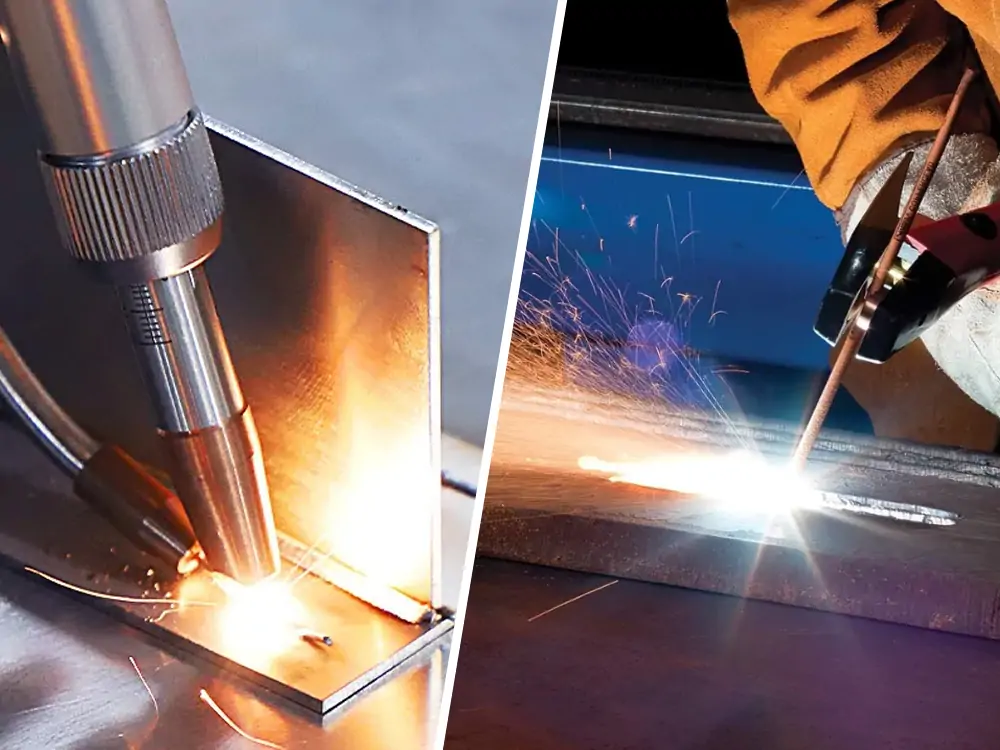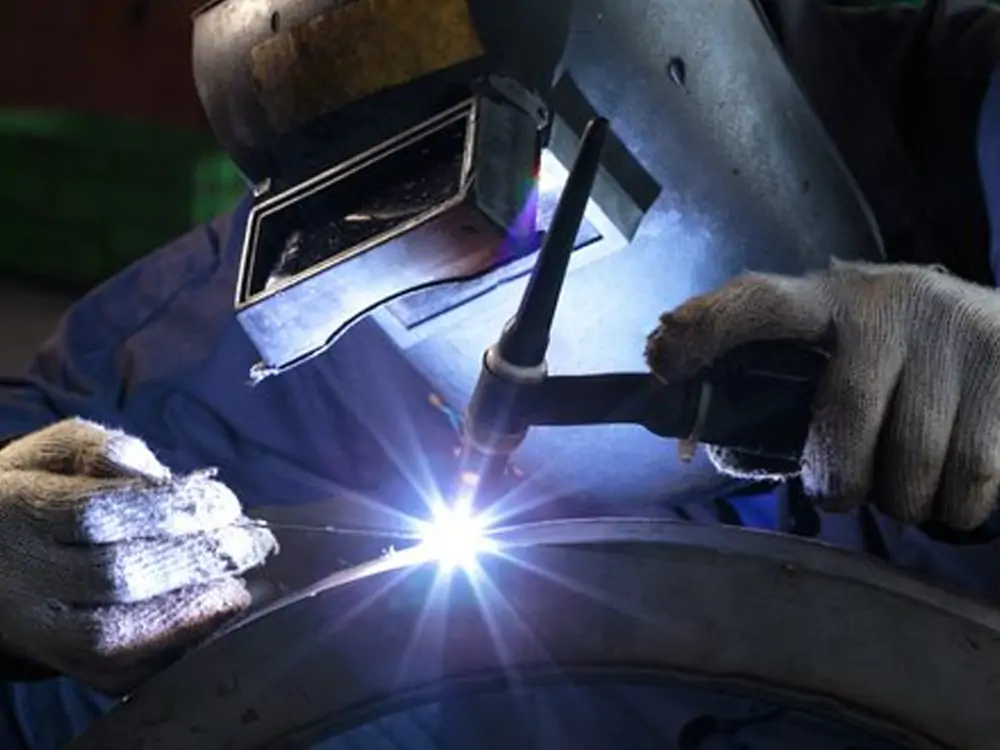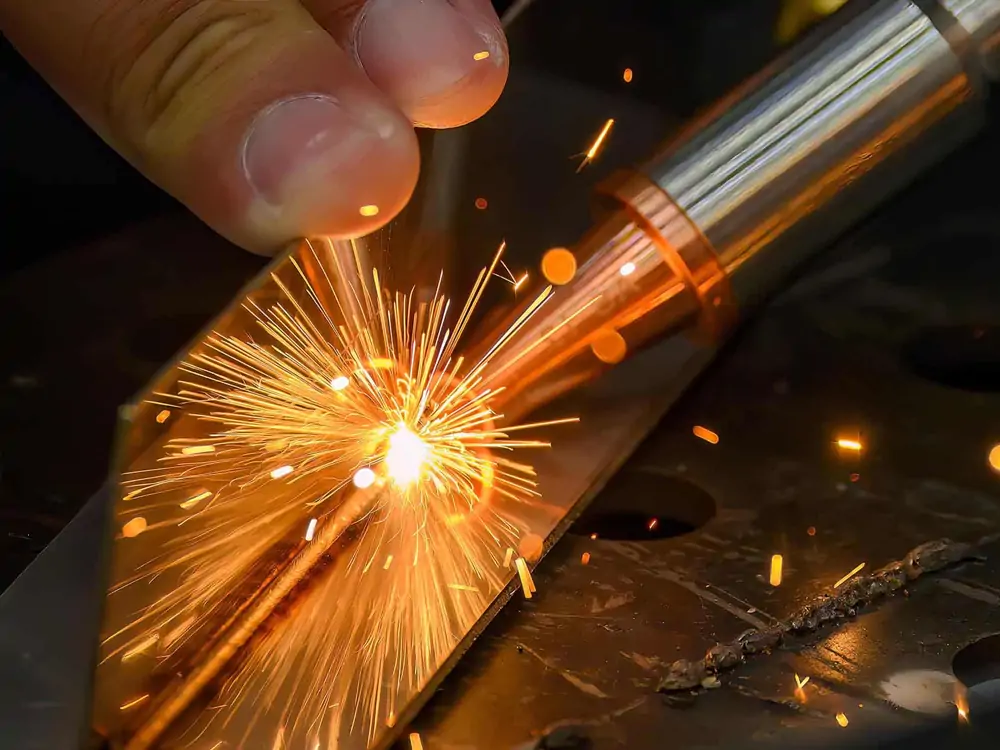You must be looking for the correct welding technique, but you have not been able to choose one yet. If we are correct, then you are not alone. Many beginners or enthusiasts find it tricky to choose between different welding techniques. This article, “Arc Welding VS Laser Welding,” can help you choose between these two popular methods.
Welding is a critical process of joining metal parts. People widely use it in manufacturing, automotive, and various other industries. You may have already found multiple kinds of welding techniques. It is pretty tricky to find the best option. Arc welding and laser welding are the two most common methods.
Arc welding is typically famous for general construction, heavy industries, and repair. This process is also cost-effective and widely available everywhere. On the other hand, laser welding is no less critical. Its popularity in the modern world has increased dramatically, especially in the twentieth century.
This article will discuss the main difference between these two ways of welding. To tell them apart, it will use six different factors. We hope this article can be beneficial to your research. In addition, it can help you choose the correct method for your project.

Laser Welding VS Arc Welding: What’s the Difference?
Laser welding and arc welding are both well-known for their unique benefits. Laser welding, as the name implies, uses laser beams for the job. On the other hand, arc welding uses arcs to do so. Laser welding is famous for its excellent precision and efficiency. On the other hand, arc welding is cheaper and can deal with thicker metal sheets. Let’s check out their difference in brief.
Arc Welding VS Laser Welding: How Do they Work?
Arc welding and laser welding have different working principles. Although they have the same purposes, both approaches utilize different technological processes. Consequently, the weld quality of these two methods is different. You will learn more about why in the later sections.

Arc welding produces a molten metal connection using an electric arc. The arc generates heat over 6,500°F between an electrode and the base materials. The process softens the metal edges, which fuse them in the cooling phase. The method uses a DC and an AC power supply. The electrode is used as a positive pole, and the base materials are used as a negative pole.
Filler metal can also strengthen the weld. Some arc welding methods also use shielding gas or flux to prevent air contamination. However, arc welding is widely popular in construction, manufacturing, and repair services.
On the other hand, the laser welding process is much cleaner. This method uses a highly focused laser beam to hit the targeted area to melt and join metal parts. Since the process is highly focused, it only melts the area you want to weld. Because of this, you can achieve a good and robust weld joint.
There are two types of laser welders: handheld and automated. Both are widely used in various industries, but the handheld machine is more commonly used.
Laser welding typically generates faultless, high-quality welds with minimum spatters. It is famous in the automotive, aerospace, electronics, and medical industries. High-precision applications usually prefer laser beam welding as their first choice.
Arc Welding VS Laser Welding: Setup and Portability
Both processes have different setups and portability, and you are looking for something convenient for your work.
Setup is difficult and relatively complicated when starting with arc welding. It is usually bulky, so it may be inconvenient for location transition. The best thing about this method is its low initial price. Arc welding can also be done in various environments. However, this method produces intense UV and IF radiation. Therefore, you must be aware of wearing protective gear.
On the contrary, laser welding is excellent in portability and setup. It is easy to carry from one place to another without any problems. Also, it is much faster than arc welding, ensuring high-precision work. The process has features like an advanced cooling system, a customization solution, and more.
Arc Welding VS Laser Welding: Ease of Use

Today’s world heavily depends on automation and digitalization to function correctly. People prefer automated items that are highly productive and efficient.
Laser beam welding is a popular example of a productive machine with a friendly user interface. Because of this, people with little knowledge of laser welding can easily control it. Thus, you don’t have to add expert costs. You can modify the laser setting according to your specific material. Besides, it is perfect for complex metal works.
However, arc welding is quite complex for beginners. Heat generation, edge-cutting, and other problems are common with this method. Functioning arc welding requires technical knowledge, a high investment, and a controlled environment. Therefore, expert workers are needed.
The outcome of arc welding is less precise than that of laser welding. Heat production is another common problem with this method. Therefore, arc welding is not suitable for working with thin metal sheets.
Arc Welding VS Laser Welding: Cost
Arc welding is typically cheaper than laser welding. Besides, its spare parts are also widely available. Thus, its repair and maintenance costs are also more affordable.
Arc welding equipment is widely available and affordable for all buyers. Regular Arcweld machines start at $200 to $500. Advanced TIG welders could cost $5,000 or more. Industrial arc welding machines cost around $1000 to $5000.
However, arc welding requires a powerful electricity supply. Besides, this method needs expert hands for the best results. All these add a significant amount of operational costs. So, although the initial cost is cheap, complete ownership is relatively expensive.
On the other hand, industrial-grade laser welders cost more than $100,000, while regular ones cost only $10,000. Even though these tools look pricey, they work in a way that saves money. They are also easy for beginners, so the work cost is lower. Typically, this process doesn’t require wire feeding. However, if you need welding that is more than 0.3mm, you may have to consider it.
Entry-level fiber welders range from $2500 to $10,000, while handheld laser welders start from $4600 to $5200. Mainly, the process profits from mass and fast production. So, the laser welder always stands superior to the arc welder.
Both techniques are good, but laser welding seems more profitable. Lastly, everything depends on budget, project demands, and company standards.
Arc Welding VS Laser Welding: Productivity
The actual success or failure of every project depends on its productivity levels. The key factor for success lies in optimizing the entire operation. Also, productivity heavily depends on speed, accuracy, and post-processing work.
Arc welding consumes time in the process. The process generates heat, which may distort the metal. Additionally, the welding process needs cleaning procedures and finishing work. However, it is a reliable and cost-effective method, especially for thick materials.
The laser welding process provides quick service with the best result. Heat started to warp a small area after decreasing laser beam movement. It also increases precision by the time of operation. For this, there is little need for post-welding cleanup. That’s why it is famous for large-scale projects.
Speed and accuracy are the two factors that make laser welding an optimal choice. Besides, arc welding would be a good choice for a low-range budget.
Arc Welding VS Laser Welding: Application

Arc welding and laser welding also have distinct applications. Both are popular techniques for joining metals in various industries.
Arc welding is extremely popular in shipbuilding, pipeline, and construction. It works well on thick metal and is affordable for clients. Due to its affordability, the process is often used in repair, automation frames, and steel bridges. However, arc welding creates high heat, which can cause the warping of materials.
On the contrary, the laser welding method is applied in aerospace, medical devices, electronics, and others. It is also popular among the jewelry industries. Many small ornaments are very difficult to weld with eyes. The laser welding method makes it easier for you to weld them. Also, it works with excellence on thin or thick materials and delicate components.
Summary
Let’s wrap everything up! You have gone through a comprehensive comparison between arc welding and laser welding. The article highlighted six critical factors about these two weddings. Surely, it will help you choose the proper work method.
Arc welding is a traditional method that uses electrodes and weld rods. The high resistance typically creates intense heat to melt the welding rod and the base metals. This method is quite effective for heavy-duty applications. Although this machine is cheaper, it requires high maintenance, operation, and labor costs.
Laser welding, on the other hand, is a more digital solution. It uses a highly focused laser beam, creating intense heat at the focused point. Because of this, the laser only melts the place it directs the energy. Ultimately, you get an exact and accurate welding. Although the laser welding machines are relatively costlier. But it is very beginner-friendly and has a lower maintenance cost.
Arc welding is widely popular in construction, manufacturing, and heavy-duty applications. On the other hand, laser welding is widely popular in electronics, jewelry, automotive, and other industries. Feel free to reach out if you have any questions.
